Do you know the song "Bring Happiness to the World" which has been sung at elementary schools in Kobe since the great earthquake 20 years ago? It was composed by Mr. Makoto Usui, a music teacher at Nishinada Elementary School. The wistfully sad and soft melody has continued to encourage and instill hope among the disaster victims of Kobe.
We are strong in spirit to be
Against the Great Quake in victory
We're thankful that we are here today
And remember the precious lives as we pray
We have rebuilt Kobe to be
As beautiful as in our memory
With hope for tomorrow in our hearts
We reach helping hands to you
The song has been translated into 10 languages and sung in disaster-struck areas as "the song of hope."
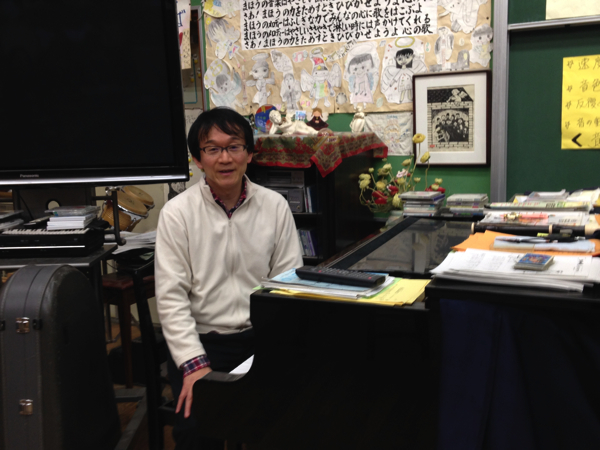 Music teacher uses original compositions in teaching
Music teacher uses original compositions in teaching
Since his kindergarten days, Mr. Usui used to make up lyrics describing distinctive features of his friends and sing them to music he created and played offhand on the organ. At university, he studied voice and took the education course as well. After graduation, he was assigned as a teacher to Shiriike Elementary School in Nagata Ward, Kobe City.
It was in his second year there that he began to compose songs for the children. He was motivated by a teacher at a nearby school who composed original songs to be sung when camping.
He composed a camping song titled "Harmony of the Heart" in the image of the popular song "Wings to Fly" and sang it with the children. When he later heard the children singing the song in the schoolyard, he was elated and became confident with his songwriting.
To date, he has written more than 350 songs. The number of songs he wrote was particularly high immediately before the Great Hanshin-Awaji Earthquake, numbering around 150. The last of the group of these songs was "Bring Happiness to the World."
Dawn that never comes: I might die in the next quake
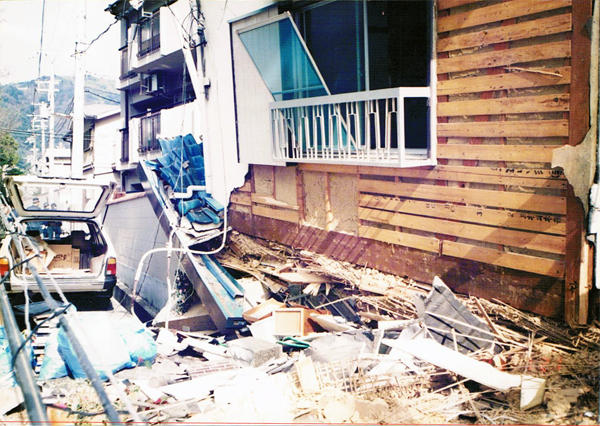 Photo: The second floor of Mr. Usui's home crushed the ground floor. Mr. Usui escaped from here and walked in indoor slippers for 10 km to a relative's home.
Photo: The second floor of Mr. Usui's home crushed the ground floor. Mr. Usui escaped from here and walked in indoor slippers for 10 km to a relative's home.
In the morning of the fateful day, Mr. Usui was in his room on the second floor and experienced huge vertical tremors and thunderous rumbling of the earth. He heard glass cracking throughout the house and electric wires snapping outside. He could not tell what was happening in the darkness. With each aftershock, he was overcome by fear that he would die in the next one and patiently waited for the dawn to break.
The second floor of the house fell and crushed the entire ground floor. When the quakes subsided, he trembled at the thought that he might have died. He realized that human lives can be taken away so easily.
The loss of his home was something unimaginable until then. With aged parents, he was unable to go to the school that served as an evacuation center. But he was motivated strongly by the kind words of the school principal, advising him to "deal with the house first, before reporting to work." He learned later that the principal himself lived in Nagata-ku and suffered damage but still treated him with kindness.
Several days after the quake, he went to work from the home of a relative who took him in. The damage in the surroundings of his elementary school were relatively minor, but the school had turned into an evacuation shelter.
Aided and encouraged by music himself
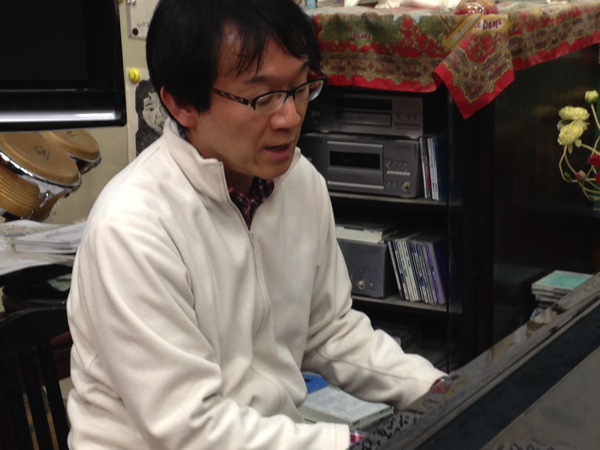 Photo: The music classroom at Nishinada Elementary School
Photo: The music classroom at Nishinada Elementary School
Since schoolteachers at public elementary schools are civil servants, they must assist in the administration of the evacuation center opened at the school, in case of a major disaster. Many suffered traumatic experiences such as finding their students in morgues.
In the busy day-to-day operations of the evacuation center, it was roughly two weeks later that he saw the conditions in Sannomiya on the TV news.
Witnessing the destruction in the city of his boyhood memories, he was overwhelmed by an urge and, grabbing a pencil he found nearby, composed the song.
We are strong in spirit to be.
The starting phrase expressed his determination to take action and also to speak to the children traumatized by the disaster. He said he finished the song in a matter of minutes.
In mid-February, he taught the song first to the children in third grade. Hearing the song, the volunteer workers wept. Later, the song sung by the children was recorded on cassette tape and played on the school's PA system each morning before the exercise program broadcast.
Additionally, Mr. Tomoji Kaku who had been supporting Mr. Usui played the tape at a faculty meeting, in hope that the song would serve as a bridge between the children and the evacuees, once classes resume. Hearing the song, the teachers applauded.
It was then that he felt that "there was something he could do." After the earthquake disaster, he at times thought that "music teachers were useless, and I should have died." With the song, however, he felt relieved and inspired.
"Bring Happiness to the World" becomes a song of recovery from disaster
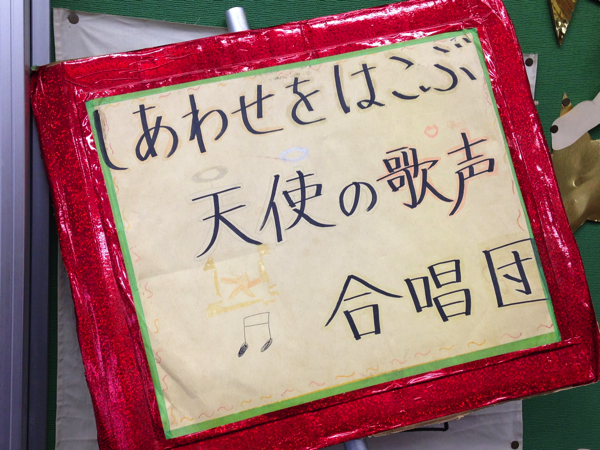 Photo: "Chorus of Angel Voices Bringing Happiness to the World" written on the placard. This is a treasure that Mr. Usui keeps in the music classroom.
Photo: "Chorus of Angel Voices Bringing Happiness to the World" written on the placard. This is a treasure that Mr. Usui keeps in the music classroom.
The title "Bring Happiness to the World" was inspired by "delivery of music" by schoolchildren that Mr. Usui started roughly a year before the earthquake disaster. The children carried the placard saying "Chorus of Angel Voices Bringing Happiness to the World" to bring music into the principal's office and into the school kitchen. This eventually grew to the chorus going outside the school to sing in various venues.
Seeing people weep with joy listening to their singing, the children learned to reach into the hearts of people through song. He initially planned the song to be titled "Song to Bring Happiness”, but his friend and fellow schoolteacher Masaru Detani suggested change.
"Bring Happiness to the World" added a sense of continuity. Without his advice, the title would not have been what it is now.
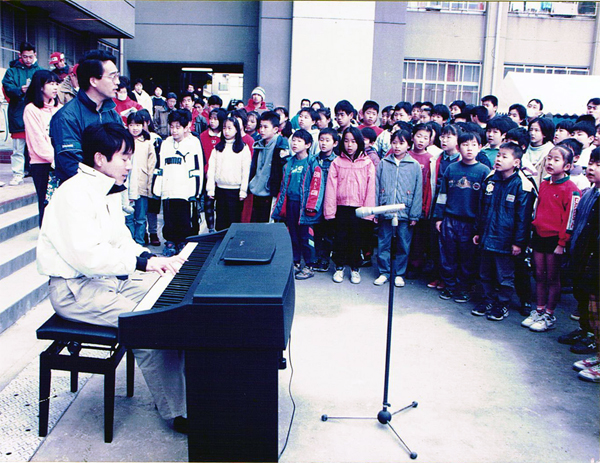 Photo: February 27, 1995, when Mr. Usui played the piano and sang the song with the children at a morning meeting held at the time of resuming classes.
Photo: February 27, 1995, when Mr. Usui played the piano and sang the song with the children at a morning meeting held at the time of resuming classes.
On February 27, 1995, roughly a month after the earthquake, classes resumed at Azuma Elementary School. At the morning meeting of the first day, Mr. Usui played the electronic piano and the children sang "Bring Happiness to the World." The people at the evacuation shelter sang along. The song was reported by Sankei Shimbun newspaper as a song of recovery from the disaster and gained recognition as the symbol of recovery.
Translated into 10 languages, the song expressed love for the hometown regardless of region
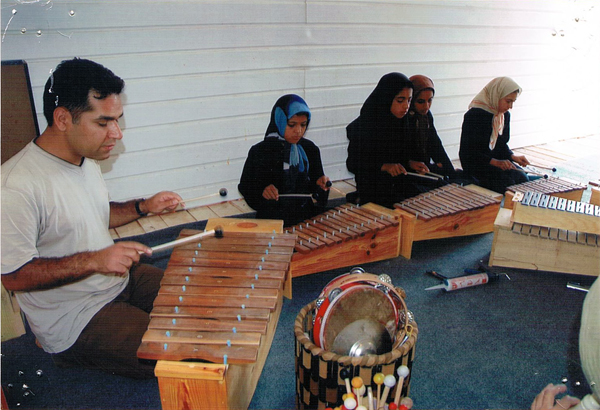 Photo: Iranian children playing musical instruments and singing "Bring Happiness to the World" in the local language
Photo: Iranian children playing musical instruments and singing "Bring Happiness to the World" in the local language
The song is now sung at elementary schools in Kobe, as well as the lighting ceremony for Kobe Luminarie illumination and at the coming-of-age ceremony of Kobe City.
In June 2004, the Persian version of the song was created in Bam, which suffered a great earthquake disaster a year earlier. In the Chuetsu Earthquake of October 2004, the song was sung at the temporary housing area in Ojiya City, with "Kobe" in the lyrics replaced with the city name "Ojiya." The song has been translated into 10 languages to date and is sung all over the world.
Fifteen years after the earthquake, the song was performed by the children of Sumiyoshi Elementary School with conductor Mr. Hiroshi Sado, in front of Crown Prince Naruhito. Deeply impressed, the Crown Prince suggested whether the song can be spread to other countries. This prompted the production of DVDs in Chinese and English. The following year, Mr. Usui was given the opportunity to speak in front of the members of a UN delegation at the Shanghai Expo.
The song has such strong power and drew me to go to various places together. It had great magnetism. Although the pain in the heart cannot go away, I think the power of music lies in lessening the pain, even a little.
Communicating the message of "singing with feeling of a prayer"
 * Video:https://www.youtube.com/watch?v=nQufiNohlLM/ (in Japanese.)
* Video:https://www.youtube.com/watch?v=nQufiNohlLM/ (in Japanese.)
The song symbolizing recovery, "Bringing Happiness to the World" from Kobe to eastern Japan, the rest of Japan and to the world (from YouTube)
The song "Bring Happiness to the World" became an underlying theme for the TV drama titled "LIVE! LOVE! SING!" aired on NHK TV on March 10, 2015. In a scene in the drama, a high school student who evacuated from Fukushima to Kobe is angered by the lyrics "rebuilt Kobe (hometown) to be as beautiful as in our memory," protesting that "Fukushima was made unlivable because of the nuclear plant accident and can’t be rebuilt as before."
In the last scene, the girl sings the song, feeling that "no one can stop people from praying, and we can sing a song as a prayer." She feels relieved that there is no turning back but there is transformation.
Only roughly one third of teachers in Kobe experienced the earthquake. It is a fact that the sense of importance of January 17 now varies widely by region, even within Kobe. As survivors of the disaster, we need to teach children that there were people who wanted to live but couldn't. We need to have "Bring Happiness to the World" sung as a prayer by the children. So the children will feel empathy toward people suffering and grow up to be kind.
At a music event held at an evacuation center immediately after the disaster, a person who heard the song told Mr. Usui, "The god of music is there listening to the song." It may have been the god of music who inspired him to write the song.
When all hope is lost, all you can do is pray. And this prayer can be shared by many in song. "Bring Happiness to the World" will certainly carry a prayer, reaching far and wide to people who wept over their "ravaged hometowns."
(Interviewed and written by Kyoko Sugimoto)
This article was created with the cooperation of
greenz.jp.
![]() a teacher
a teacher JP | EN
JP | EN JP | EN
JP | EN
 Photo: The second floor of Mr. Usui's home crushed the ground floor. Mr. Usui escaped from here and walked in indoor slippers for 10 km to a relative's home.
Photo: The second floor of Mr. Usui's home crushed the ground floor. Mr. Usui escaped from here and walked in indoor slippers for 10 km to a relative's home. Photo: The music classroom at Nishinada Elementary School
Photo: The music classroom at Nishinada Elementary School Photo: "Chorus of Angel Voices Bringing Happiness to the World" written on the placard. This is a treasure that Mr. Usui keeps in the music classroom.
Photo: "Chorus of Angel Voices Bringing Happiness to the World" written on the placard. This is a treasure that Mr. Usui keeps in the music classroom. Photo: February 27, 1995, when Mr. Usui played the piano and sang the song with the children at a morning meeting held at the time of resuming classes.
Photo: February 27, 1995, when Mr. Usui played the piano and sang the song with the children at a morning meeting held at the time of resuming classes. Photo: Iranian children playing musical instruments and singing "Bring Happiness to the World" in the local language
Photo: Iranian children playing musical instruments and singing "Bring Happiness to the World" in the local language * Video:https://www.youtube.com/watch?v=nQufiNohlLM/ (in Japanese.)
* Video:https://www.youtube.com/watch?v=nQufiNohlLM/ (in Japanese.)